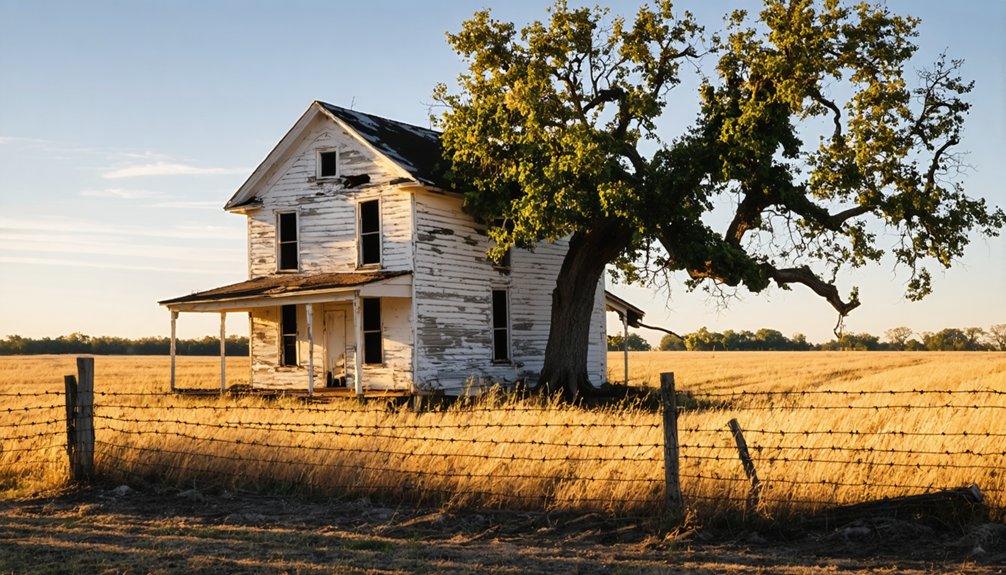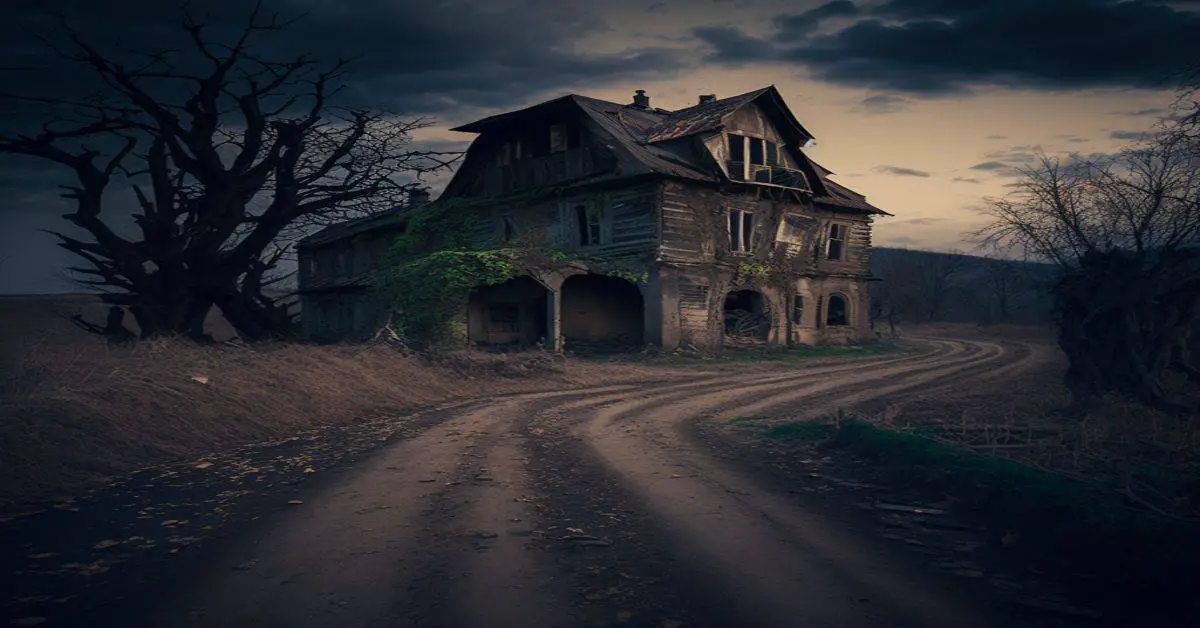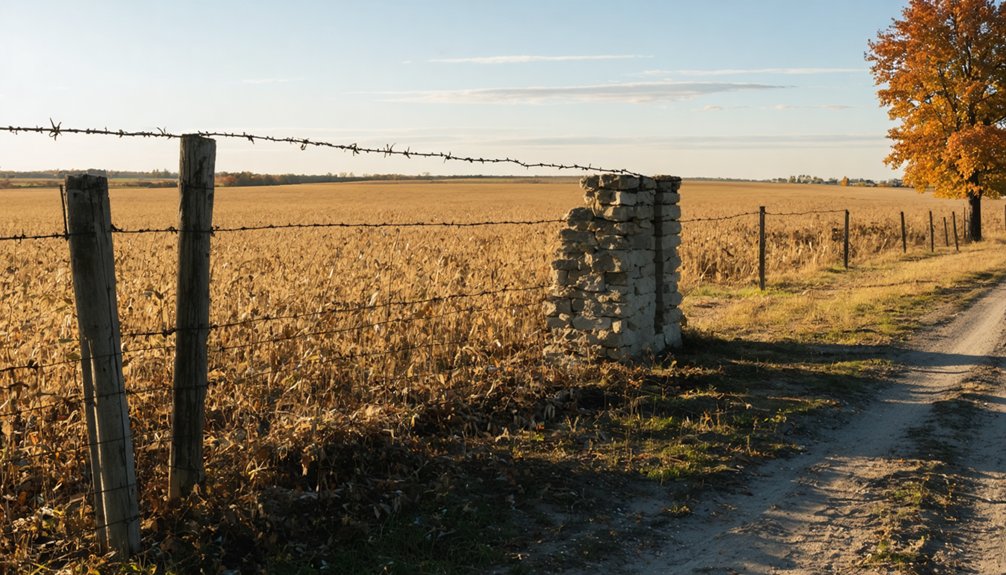You’ll find the remnants of Totten Prairie in Fulton County, Illinois, where William Totten established a pioneer settlement in 1823. The community thrived initially through farming and trade with Native Americans, featuring a fortified blockhouse built during the 1827 Winnebago troubles. While the settlement declined after being bypassed by railroads, you can still discover archaeological evidence of daily life, including storage pits and tools, with only the cemetery remaining as a visible marker of this lost prairie town.
Key Takeaways
- Totten Prairie, established in 1823 by William Totten, was once a thriving frontier settlement in Fulton County, Illinois.
- The community featured a fortified blockhouse built in 1827 during conflicts with Native American tribes.
- Archaeological evidence reveals the settlement’s transition from hunting to farming through discovered artifacts and structural remains.
- The settlement declined after being bypassed by major railroads and transportation routes in the mid-1800s.
- Today, only the cemetery remains as physical evidence of Totten Prairie’s existence as one of Illinois’ ghost towns.
A Pioneer’s Legacy: William Totten’s Settlement
When William Totten arrived in Fulton County, Illinois, in 1823, he established what would become known as Totten Prairie in the southwest quarter of Section 27 of Cass Township.
During the Winnebago troubles of 1827, he helped construct a fortified blockhouse to protect the settlement.
As the area’s first pioneer, you’ll find that Totten’s legacy extends beyond mere settlement – he forged peaceful relationships with Native Americans, engaging in trade and fostering mutual respect during a time of significant territorial changes.
Totten’s influence on community governance grew as he stepped into roles of local leadership, serving as both a Constable and Grand Jurist.
Taking on dual roles as Constable and Grand Jurist, William Totten shaped early governance while establishing himself as a respected community leader.
His settlement attracted other pioneers to the region, spurring the development of nearby communities like Cameron.
While Totten Prairie itself didn’t survive as a permanent town, its founding helped lay the groundwork for Fulton County’s early development and left an enduring mark on Illinois’ frontier history.
Today, only an old cemetery on private property remains as evidence of this once-promising settlement.
Life on the Illinois Prairie in the 1820s
The vast Illinois prairie of the 1820s presented settlers with both abundant opportunities and formidable challenges.
Early settlers described encounters with tall perennial flowers stretching across the landscape as far as the eye could see.
You’d find yourself surrounded by an endless sea of grass, with trees visible only along distant waterways or in scattered prairie groves. Your prairie survival depended on careful planning and agricultural adaptation.
The fertile land once supported over 300 species of native plants before settlement began.
You couldn’t simply plow the thick sod with wooden tools – you’d need a massive plow pulled by six or more oxen, and you’d spend countless hours cleaning sticky soil from your plowshare.
For shelter and fuel, you’d likely settle near wooded areas first, using timber for your cabin and fences.
You’d learn to fear prairie fires, which could destroy everything you’d built in minutes, and you’d need to master drainage techniques to farm the wet prairie soil successfully.
The Rise and Fall of a Farming Community
Pioneer William Totten established the prairie community bearing his name in 1823, staking his claim to the southwest quarter of section 27 amid the fertile Illinois grasslands.
Despite pioneer challenges like the Winnebago troubles and Black Hawk War, the settlement thrived through farming and maintained peaceful relations with Native Americans, particularly Black Hawk himself who protected the community.
The settlers benefited from overland travel paths that previous pioneers had already cleared through the territory. You’d have found typical agricultural practices of the era, with settlers working the rich soil while staying vigilant through their fortified blockhouse.
But as railroads and major roads bypassed Totten Prairie, the once-promising settlement gradually faded, much like how the Chicago & Pacific line caused the decline of nearby Henpeck in the 1870s.
Today, only the cemetery remains as a monument to this resourceful farming community, marking where hardy pioneers once carved out their independence on the Illinois frontier.
Traces Left Behind: Archaeological Evidence
Modern archaeological surveys have revealed extensive physical evidence of Totten Prairie‘s former inhabitants beneath today’s farmland.
Beneath modern farmland lies a treasure trove of archaeological evidence, revealing the rich history of Totten Prairie’s ancient inhabitants.
You’ll find settlement patterns emerging from magnetometry data showing at least two dozen buried structures, while excavated storage pits contain elk bones and tools that tell the story of daily life. Similar to findings at the Marseton #2 site, the circular layout suggests year-round occupation of the area.
The site’s cultural interactions are particularly visible through:
- Mixed pottery styles showing both Mississippian shell-tempered and Langford rock-tempered techniques
- Double-pointed knife blades crafted from imported white chert
- Elk bone scrapers and cooking pits with fire-cracked rock
The evidence spans from AD 650-925, revealing how the community evolved from hunting to farming.
You can trace their progression through layers of artifacts, from early periods lacking corn to later strata rich with maize remains.
Copper beads and tobacco seeds were among the significant discoveries made during careful soil screening.
Ghost Towns of the Prairie State
While archaeological evidence reveals the ancient settlements of Illinois, countless ghost towns from more recent centuries dot the Prairie State’s landscape.
You’ll discover Ostend, founded by Ohio migrant Eber Norton in the 1840s, where only a well-maintained cemetery and scattered foundations remain.
Your ghost town exploration might lead you to Totten Prairie, settled in 1823 by William Totten, who built a fortified blockhouse during the Winnebago troubles.
Prairie history comes alive in places like Murpheysboro, platted in the 1830s but abandoned after railroads bypassed it.
Like the town of Wanboro, many settlements were established as model English communities but ultimately failed when their founders passed away.
The Digital Research Library offers detailed maps showing the locations of these lost communities throughout Illinois.
These settlements often failed when transportation routes shifted, economic ventures collapsed, or legal challenges arose.
While some towns have vanished completely, others left behind cemeteries, foundations, and cellar holes as silent witnesses to Illinois’ pioneer past.
Frequently Asked Questions
What Happened to William Totten’s Descendants After the Town’s Abandonment?
You won’t find clear records of Totten’s descendants’ whereabouts, as the Totten legacy remains largely undocumented. Most descendant stories were lost when families likely scattered during typical frontier migration patterns.
Were There Any Notable Disasters or Epidemics That Affected Totten Prairie?
You won’t find records of major disease outbreaks or natural disasters striking this settlement. While nearby Illinois towns faced various hardships, Totten Prairie’s decline stemmed from migration and economic changes.
What Crops Were Primarily Grown by Totten Prairie’s Early Settlers?
You’ll find corn dominated early agriculture in the area, with wheat and oats following in crop rotation patterns. Farmers also maintained truck patches growing potatoes, cabbage and pumpkins for sustenance.
Did Native American Tribes Interact With the Totten Prairie Settlement?
You’ll find it rejuvenating that tribal relations at Totten Prairie were unusually peaceful – with Native Americans regularly visiting William Totten’s settlement for trading, cultural exchange, and socializing, even when “on the warpath.”
What Was the Peak Population of Totten Prairie During Its Existence?
You can’t find exact records of the peak population, but given its historical significance and eventual population decline, estimates suggest Totten Prairie likely housed fewer than 200 settlers at its height.
References
- https://northwestchicagoland.northwestquarterly.com/2023/09/27/ghost-towns-of-the-old-northwest/
- https://www.heraldtimesonline.com/story/lifestyle/home-garden/2021/01/15/some-illinois-ghost-towns/43846097/
- https://www.youtube.com/watch?v=93k0qtvzkn4&vl=en-US
- https://drloihjournal.blogspot.com/2022/09/lost-towns-of-illinois-totten-illinois.html
- https://drloihjournal.blogspot.com/search/label/Lost Towns of Illinois
- http://genealogytrails.com/ill/jefferson/ghostowns.html
- https://storymaps.arcgis.com/stories/043201d4267e4a66b44e7922832df7a2
- https://en.wikipedia.org/wiki/List_of_ghost_towns_in_Illinois
- https://libsysdigi.library.uiuc.edu/OCA/Books2008-08/americanaerialco/americanaerialco02drur/americanaerialco02drur.pdf
- http://cantontornado36.blogspot.com/2017/04/ghost-towns-of-fulton-county-illinois.html



